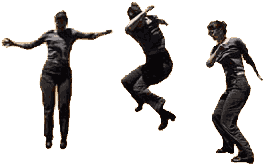Activity: Mid-Air Maneuver
To understand how skaters turn in midair, try this little experiment. You can do it on your own, but an assistant to help you will make your results all the more convincing.
1. Find a clear area and stand there, facing your assistant.
2. Jump into the air. Just as you become airborne, your assistant should point either to your left or right. Now, while you're still in the air, quickly turn your body 90 degrees in the direction that your assistant pointed. (If you have no assistant, just decide in midair which way you will turn and then turn that way.)

3. This isn't easy, so give it a few tries. You'll find it's much easier on a trampoline or diving board, both of which give you more time to respond.
What's going on?
If you managed to pull this off, then guess what: You've just turned in midair while keeping your angular momentum constant at zero. The arbitrary choice of your assistant guarantees that you didn't get your rotation by pushing off from the ground. So where did you get it? Your upper body.

As you rotate your legs 90 degrees beneath you, your arms and torso rotate in the opposite direction. You probably found yourself naturally sticking your arms out as you turned—this increases the rotational inertia of your upper body. The upshot is that a large rotation of your legs is exactly cancelled by a small rotation of your outspread arms. Since the two rotations cancel, angular momentum stays constant at zero, and the law of conservation of angular momentum is satisfied. (Whew.)
In much the same way, skateboarders turn in midair by twisting their arms and legs in opposite directions. Upon landing, a skater can use the friction between his or her feet and the skateboard to twist the upper body back into alignment.
Have you ever heard the saying that a cat always lands on its feet? Anyone who has a cat knows it's not true, but cats are known to use a similar trick to turn in midair.
A falling cat extends its rear legs and twists the front half of its body toward the ground. The rear half rotates in the opposite direction, but not as far. Then the cat extends its front legs and twists its tucked rear legs toward the floor. By repeating these motions, the cat may gain sufficient net rotation to land with its paws on the ground.